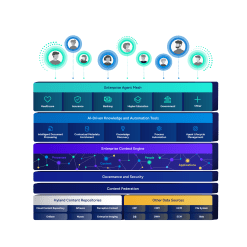The evolving need for intelligent information management
ECM platforms have been a cornerstone of business operations since the early 2000s, providing governance and control over documents and data. However, today’s business landscape is fundamentally different, and the tools used to manage information are rapidly evolving.
Traditional ECM platforms face several critical limitations that hinder their effectiveness in today's environment.
Aging platforms
Many legacy ECM systems are built on dated, monolithic frameworks. This architecture leads to limited functionality, makes integration with modern applications challenging, and results in expensive development and maintenance cycles for any customizations or add-ons.
Cloud limitations
Initially, many ECM vendors and their customers were hesitant to adopt the cloud. But the undeniable need for anytime, anywhere access to content, coupled with growing confidence in cloud security, is driving more companies to make the switch, with 92% of respondents to a Forrester study reporting they’re investing in cloud/web-based applications that simplify working remotely and from a variety of devices to support content strategy. A core requirement for any modern content strategy is ensuring management tools are not just cloud-ready, but fully functional and optimized for the cloud.
> Read more | Modern cloud content management: The emergence of cloud-enabled ECM
Limited innovation
The intense focus required to rearchitect legacy systems for modern infrastructures often leads to a drop in innovation. Users of these older platforms miss out on transformative capabilities like artificial intelligence, content intelligence and intelligent automation. They also lack integration with modern collaboration tools and simplified user interfaces, putting them at a significant competitive disadvantage.
Continued high implementation costs
Deploying traditional ECM systems typically involves careful planning, long development cycles and extensive user training. This combination results in high implementation and maintenance costs, especially when compared to the flexible, consumption-based pricing models and extensive customization options available with modern platforms.
Information sprawl
For years, vendors promised a single system to store all an organization's content. This promise was never fulfilled. Instead, businesses ended up an average of 21 repositories, according to Forrester, and these disconnected information systems were never designed to work together. The result is a chaotic landscape of aging platforms, abandoned collaboration sites and isolated departmental solutions. This information sprawl makes it nearly impossible to leverage unstructured data to make swift, informed decisions and improve business efficiency.
These shortcomings highlight a clear need for a new approach — one that embraces the cloud, fosters innovation and provides the agility modern organizations require to get their intelligent information management strategies right.

















